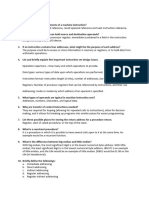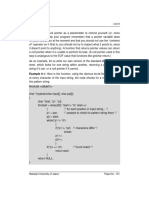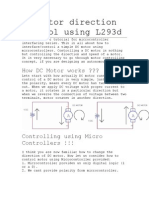CA Classes-166-170
CA Classes-166-170
Uploaded by
SrinivasaRaoCopyright
Available Formats
Share this document
Did you find this document useful?
Is this content inappropriate?
Report this DocumentCopyright:
Available Formats
CA Classes-166-170
CA Classes-166-170
Uploaded by
SrinivasaRaoCopyright:
Available Formats
Computer Architecture Unit 7
One of the unusual characteristic from the desktop point of view is that the
programmer is allowed to state five autonomous operations that can be
issued simultaneously. In case the five autonomous instructions are not
available (which means that others are dependent), then no operations
(NOPs) are positioned in the remaining slots. We call this method of
instruction coding a VLIW (Very Long Instruction Word) method.
It is known that as Trimedia TM32 CPU comprise longer instruction words
and frequently includes NOPs, the instructions of Trimedia are compressed
in the memory. Also the instructions are decoded to the full size when they
are loaded into cache. In Figure 7.8, we have shown the TM32 CPU
instruction mix for EEMBC bench-marks.
Figure 7.8: TM32 CPU Instruction Mix for EEMBC Customer Benchmark
Manipal University of Jaipur B1648 Page No. 166
Computer Architecture Unit 7
By means of source code which is unmodified, instruction mix is analogous
to others, even though more byte data transfers are there. For aligning the
data for SIMD instructions, the huge number of pack is observed and the
instructions are merged. Computers used for general purpose (having
higher importance byte data transfers) and the instruction mix for “out-of-
the-box” C code is considered similar to each other. The Single instruction,
multiple data (SIMD) instructions along with the pack are used by means of
the hand-optimised C code. Also the instructions are merged so to align the
data.
The comparative instruction mix for unmodified kernels is represented by
means of, middle column. On the other hand, modification at the C level is
allowed by right column. All the operations that were accountable for at least
1% of the total in any of the mixes are listed by these columns.
Self Assessment Questions
13. Trimedia processor may be the closest existing processor to a
____________________________.
14. State two uses of Trimedia TM32 CPU.
7.9 Summary
Implementation of branching is done by using a branch instruction. The
address of target instruction is included in the branch instruction
The branch penalty can be reduced to one cycle. It can be efficiently
reduced further by means of Delayed branch execution.
Effective processing of branches has become a cornerstone of
increased performance in ILP-processors.
Branch prediction is a method which is basically utilised for handling the
problems related to branch. Different strategies of branch prediction
include:
Fixed branch prediction
Static branch prediction
Dynamic branch prediction
The new architecture, generated mutually by means of Hewlett Packard
as well as Intel , is known as IA-64
IA-64 model is also known as Explicitly Parallel Instruction Computing
(EPIC).
Manipal University of Jaipur B1648 Page No. 167
Computer Architecture Unit 7
Itanium comprises a group of 64-bit Intel microprocessors which
provides execution to the Intel Itanium architecture. This architecture
was initially known as IA-64.
Interesting strategies are represented by the Crusoe chips and Trimedia
for applying the concepts of Very long instruction word (VLIW) in an
embedded space. Trimedia processor may be the closest existing
processor to a "classic" processor of VLIW.
7.10 Glossary
Branch penalty: Wasteful work done by pipelines for a considerable
time.
Condition code registers: A condition code register is used for
attaining communication among the instructions for condition as well as
branching.
EPIC: Explicitly Parallel Instruction Computing.
ILP: Instruction level parallelism.
Merced: A dual mode processor, which is capable of executing the
programs of both IA-32 as well as IA-64.
VLIW: Very Long Instruction Word.
7.11 Terminal Questions
1. Differentiate between unconditional and conditional branch.
2. Explain the concept of branch handling.
3. What do you understand by delayed branching?
4. Define branch processing.
5. What do you mean by branch prediction?
6. Write short notes on:
a) Fixed Branch Prediction
b) Intel IA-64 architecture
c) Static Branch Prediction
d) Itanium processor
e) Dynamic Branch Prediction
7. Explain the concept of Trimedia TM32 Architecture.
Manipal University of Jaipur B1648 Page No. 168
Computer Architecture Unit 7
7.12 Answers
Self Assessment Questions
1. Jump instruction
2. False
3. Branch
4. Branch penalty
5. SPARC, MIPS
6. No operation (NOP)
7. Layout, micro-architectural implementation
8. a) Detecting branches
b) Handling of unresolved conditional branches during instruction
decoding.
c) Accessing the branch target path
9. Never taken, always taken
10. Instruction opcode
11. Addresses, registers
12. Explicitly Parallel Instruction Computing (EPIC)
13. "Classic" VLIW processor.
14. Set top boxes and advanced televisions.
Terminal Questions
1. This type of branch is considered as the simplest one. It is used to
transfer control to a particular target. In conditional branches, if a
particular condition meets its requirements, then only the jump is
conducted. Refer Section 7.2.
2. Branch Handling is executed when the flow of control is altered. For
example branch requires special handling in pipelined processors.
Refer Section 7.3.
3. Delayed branching is the reduction of branch penalty to one cycle.
Refer Section 7.4.
4. Branch processing receives branch instructions and resolves the
conditional branches as early as possible. Refer Section 7.5.
5. Branch prediction predicts the outcome of branch. Refer Section 7.6.
6. a) In Fixed Branch Prediction, prediction is fixed. Refer Section 7.6.1.
b) The new architecture, generated mutually by means of Hewlett
Packard as well as Intel , is known as IA-64. Refer section 7.7.1.
Manipal University of Jaipur B1648 Page No. 169
Computer Architecture Unit 7
c) This approach makes use of instruction opcode for predicting
whether the branch is taken. Refer section 7.6.2.
d) Itanium comprises a group of 64-bit Intel microprocessors which
provides execution to the Intel Itanium architecture. This
architecture was initially known as IA-64. Refer Section 7.7.2.
e) For making more accurate predictions, this approach considers
run-time history. Here the n branch executions of history are
considered and this information is used for predicting the next one.
Refer section 7.6.3.
7. TM32 CPU is considered as an example of multimedia applications.
The multimedia applications comprise significant parallelism in
managing the data streams Refer Section 7.8.
References:
Hwang, K. Advanced Computer Architecture. McGraw-Hill.
Godse, D. A. & Godse, A. P. Computer Organization. Technical
Publications.
Hennessy, John L., Patterson, David A. & Goldberg David. Computer
Architecture: A Quantitative Approach, Morgan Kaufmann.
Sima, Dezsö, Fountain, Terry J. & Kacsuk, Péter, Advanced computer
architectures - a design space approach. Addison-Wesley-Longman.
E-references:
http://www.scribd.com/doc/46312470/37/Branch-processing,
http://www.scribd.com/doc/60519412/15/Another-View-The-Trimedia-
TM32-CPU-151.
Manipal University of Jaipur B1648 Page No. 170
You might also like
- Computer Architecture Question PaperDocument14 pagesComputer Architecture Question Paperheaughfrds100% (1)
- Lighting Control Via DALI ACU BT, DALI ECO BT, DALI ECO BT RTC or OTi BLE - OSRAM Digital SystemsDocument2 pagesLighting Control Via DALI ACU BT, DALI ECO BT, DALI ECO BT RTC or OTi BLE - OSRAM Digital SystemsHoang HaNo ratings yet
- Processor Design From Leon3 Extension Final ReportDocument44 pagesProcessor Design From Leon3 Extension Final ReportTalal KhaliqNo ratings yet
- DH-11 - Actuator HoseDocument1 pageDH-11 - Actuator HoseFlorin NedeaNo ratings yet
- SM-A305F Common Tshoo 7 PDFDocument67 pagesSM-A305F Common Tshoo 7 PDFrudy607No ratings yet
- CS 6303 Computer Architecture TWO Mark With AnswerDocument14 pagesCS 6303 Computer Architecture TWO Mark With AnswerPRIYA RAJI100% (1)
- CA Classes-146-150Document5 pagesCA Classes-146-150SrinivasaRaoNo ratings yet
- Department of Computer Science and Engineering Subject Name: Advanced Computer Architecture Code: Cs2354Document7 pagesDepartment of Computer Science and Engineering Subject Name: Advanced Computer Architecture Code: Cs2354kamalsomuNo ratings yet
- CA Classes-221-225Document5 pagesCA Classes-221-225SrinivasaRaoNo ratings yet
- Chapter 6 - Introduction To An Embedded System and ITs Design - Microcontrollers & Embedded SystemsDocument16 pagesChapter 6 - Introduction To An Embedded System and ITs Design - Microcontrollers & Embedded SystemsAmish VermaNo ratings yet
- CS6303 Computer Architecture Two MarksDocument19 pagesCS6303 Computer Architecture Two Markskayalvizhimurugan80% (5)
- Coa Unit Test QP 1Document7 pagesCoa Unit Test QP 1Sagar K Dedhia0% (1)
- CS6303 Computer Architecture Regulation 2013 BE-Computer Science and Engineering III Semester 2 Marks Unit-I Overview & InstructionsDocument18 pagesCS6303 Computer Architecture Regulation 2013 BE-Computer Science and Engineering III Semester 2 Marks Unit-I Overview & InstructionssathishNo ratings yet
- Computer ArchitectureT4Document7 pagesComputer ArchitectureT4Md. EmdadNo ratings yet
- 17 Bit Implementation For Dual Core Risc ArchitectureDocument6 pages17 Bit Implementation For Dual Core Risc ArchitecturelambanaveenNo ratings yet
- Aca Univ 2 Mark and 16 MarkDocument20 pagesAca Univ 2 Mark and 16 MarkmenakadevieceNo ratings yet
- Cs2253 Computer Organization and Architecture Question BankDocument10 pagesCs2253 Computer Organization and Architecture Question BankVenkat RamNo ratings yet
- Design and Analysis of A 32-Bit Pipelined Mips Risc ProcessorDocument18 pagesDesign and Analysis of A 32-Bit Pipelined Mips Risc ProcessorAnonymous e4UpOQEPNo ratings yet
- Processor Realization For Application of Convolution: Prashant D Bhirange, V. G. Nasre, M. A. GaikwadDocument5 pagesProcessor Realization For Application of Convolution: Prashant D Bhirange, V. G. Nasre, M. A. GaikwadIJERDNo ratings yet
- Design of A 32-Bit Dual Pipeline Superscalar RISC-V Processor On FPGADocument4 pagesDesign of A 32-Bit Dual Pipeline Superscalar RISC-V Processor On FPGASRIRAAM VSNo ratings yet
- Microprocessors-Quick Notes (For Exam Preparation) - ClassleDocument4 pagesMicroprocessors-Quick Notes (For Exam Preparation) - ClassleTapasRoutNo ratings yet
- Embedded System Design-NPTEL-NOTESDocument38 pagesEmbedded System Design-NPTEL-NOTESGulshan Upreti100% (1)
- Cse-Viii-Advanced Computer Architectures (06CS81) - Question PaperDocument5 pagesCse-Viii-Advanced Computer Architectures (06CS81) - Question PaperDeepak Ravi ShankarNo ratings yet
- Implementation of 5-Stage 32-Bit Microprocessor Based Without Interlocked Pipelining StagesDocument5 pagesImplementation of 5-Stage 32-Bit Microprocessor Based Without Interlocked Pipelining Stagesashish jhaNo ratings yet
- COA Solved Question Paper July 2023Document12 pagesCOA Solved Question Paper July 2023govopi6584No ratings yet
- CA Classes-76-80Document5 pagesCA Classes-76-80SrinivasaRaoNo ratings yet
- Computer Architecture 2 MarksDocument32 pagesComputer Architecture 2 MarksArchanavgs0% (1)
- Aca Important Questions 2 Marks 16marksDocument18 pagesAca Important Questions 2 Marks 16marksvimala60% (5)
- Advanced Computer Architecture (ACA) AssignmentDocument16 pagesAdvanced Computer Architecture (ACA) AssignmentSayed Aman KonenNo ratings yet
- SLM - Unit 05Document19 pagesSLM - Unit 05pavanmay227597No ratings yet
- Design of 32-Bit Risc Cpu Based On Mips: Journal of Global Research in Computer ScienceDocument5 pagesDesign of 32-Bit Risc Cpu Based On Mips: Journal of Global Research in Computer ScienceAkanksha Dixit ManodhyaNo ratings yet
- Assembly Programming: AnswerDocument22 pagesAssembly Programming: AnswerShreyas S RNo ratings yet
- Home Work 3: Class: M.C.A SECTION: RE3004 Course Code: CAP211Document15 pagesHome Work 3: Class: M.C.A SECTION: RE3004 Course Code: CAP211Vikas GuptaNo ratings yet
- Design and Implementation of 6-Stage 64-Bit MIPS Pipelined ArchitectureDocument7 pagesDesign and Implementation of 6-Stage 64-Bit MIPS Pipelined ArchitectureAiman JalaliNo ratings yet
- Coss MidSemester RegularDocument3 pagesCoss MidSemester RegularUdayChanderAmbatiNo ratings yet
- Project Report of RISC-V CPUDocument6 pagesProject Report of RISC-V CPUBilal FarooquiNo ratings yet
- Unit IIIDocument6 pagesUnit IIISheeba KelvinNo ratings yet
- Lecture Notes For ARM Architecture - Module IDocument45 pagesLecture Notes For ARM Architecture - Module Igangasani lavanya reddyNo ratings yet
- IES important model questionsDocument6 pagesIES important model questionsdivakarmass444No ratings yet
- Computer Architecture Assignment: The ARM Cortex-A53Document8 pagesComputer Architecture Assignment: The ARM Cortex-A53destiny breakNo ratings yet
- CA Classes-106-110Document5 pagesCA Classes-106-110SrinivasaRaoNo ratings yet
- Computer ArchitectDocument194 pagesComputer Architectksu2006No ratings yet
- Unit 05 Design Space of PipelinesDocument24 pagesUnit 05 Design Space of PipelinesSrinivasaRaoNo ratings yet
- Microprocessor Based System Lab ManualDocument105 pagesMicroprocessor Based System Lab ManualBurhan AhmedNo ratings yet
- Question and Answer Bank: Noorul Islam College of EngineeringDocument19 pagesQuestion and Answer Bank: Noorul Islam College of EngineeringSankari PriyaNo ratings yet
- Digital Electronics & Computer OrganisationDocument17 pagesDigital Electronics & Computer Organisationabhishek125No ratings yet
- Chameleon ChipDocument21 pagesChameleon ChipbiswalsantoshNo ratings yet
- Computer Architecture 4Document6 pagesComputer Architecture 4Soban JanjuaNo ratings yet
- NoteDocument11 pagesNoteniquegruruquo-7238No ratings yet
- Top 21 Computer Architecture Interview Questions & AnswersDocument5 pagesTop 21 Computer Architecture Interview Questions & AnswersAyush Kumar RathoreNo ratings yet
- Question Bank For Computer ArchitectureDocument23 pagesQuestion Bank For Computer ArchitecturesuryaNo ratings yet
- Computer Organization and Architecture Cs2253: Part-ADocument21 pagesComputer Organization and Architecture Cs2253: Part-AjanukarthiNo ratings yet
- Computer ArchitectureDocument125 pagesComputer Architecturebalaji bala100% (1)
- Parallel Video Processing Performance Evaluation On The Ibm Cell Broadband Engine ProcessorDocument13 pagesParallel Video Processing Performance Evaluation On The Ibm Cell Broadband Engine Processornajwa_bNo ratings yet
- # Tutorial 9 & 10Document6 pages# Tutorial 9 & 10aojiru.coNo ratings yet
- Chameleon ChipDocument21 pagesChameleon Chip429by3100% (1)
- 28609262-Chameleon-Chips-Presentation (Compatibility Mode)Document24 pages28609262-Chameleon-Chips-Presentation (Compatibility Mode)मनोज मुंद्राNo ratings yet
- Chameleon Chips PresentationDocument24 pagesChameleon Chips Presentationmanojreads100% (1)
- C Programming for the Pc the Mac and the Arduino Microcontroller SystemFrom EverandC Programming for the Pc the Mac and the Arduino Microcontroller SystemNo ratings yet
- Fundamentals of Computer Organization and ArchitectureFrom EverandFundamentals of Computer Organization and ArchitectureRating: 5 out of 5 stars5/5 (1)
- CA Classes-251-255Document5 pagesCA Classes-251-255SrinivasaRaoNo ratings yet
- CA Classes-201-205Document5 pagesCA Classes-201-205SrinivasaRaoNo ratings yet
- Computer Architecture AllClasses-Outline-1-99Document99 pagesComputer Architecture AllClasses-Outline-1-99SrinivasaRaoNo ratings yet
- Computer Architecture AllClasses-Outline-100-198Document99 pagesComputer Architecture AllClasses-Outline-100-198SrinivasaRaoNo ratings yet
- Computer Architecture AllClasses-OutlineDocument294 pagesComputer Architecture AllClasses-OutlineSrinivasaRaoNo ratings yet
- CA Classes-261-265Document5 pagesCA Classes-261-265SrinivasaRaoNo ratings yet
- CA Classes-186-190Document5 pagesCA Classes-186-190SrinivasaRaoNo ratings yet
- CA Classes-236-240Document5 pagesCA Classes-236-240SrinivasaRaoNo ratings yet
- CA Classes-106-110Document5 pagesCA Classes-106-110SrinivasaRaoNo ratings yet
- CA Classes-126-130Document5 pagesCA Classes-126-130SrinivasaRaoNo ratings yet
- CA Classes-196-200Document5 pagesCA Classes-196-200SrinivasaRaoNo ratings yet
- CA Classes-216-220Document5 pagesCA Classes-216-220SrinivasaRaoNo ratings yet
- CA Classes-26-30Document5 pagesCA Classes-26-30SrinivasaRaoNo ratings yet
- CA Classes-116-120Document5 pagesCA Classes-116-120SrinivasaRaoNo ratings yet
- CA Classes-86-90Document5 pagesCA Classes-86-90SrinivasaRaoNo ratings yet
- Programming in C - 121-140Document20 pagesProgramming in C - 121-140SrinivasaRaoNo ratings yet
- CA Classes-36-40Document5 pagesCA Classes-36-40SrinivasaRaoNo ratings yet
- CA Classes-16-20Document5 pagesCA Classes-16-20SrinivasaRaoNo ratings yet
- Programming in C - 161-180Document20 pagesProgramming in C - 161-180SrinivasaRaoNo ratings yet
- Programming in C - 21-40Document20 pagesProgramming in C - 21-40SrinivasaRaoNo ratings yet
- Tips For Writing User Friendly GMP DocumentDocument12 pagesTips For Writing User Friendly GMP DocumentSrinivasaRaoNo ratings yet
- Programming in C - 41-60Document20 pagesProgramming in C - 41-60SrinivasaRaoNo ratings yet
- C Programming AllClasses-Outline-1-98Document98 pagesC Programming AllClasses-Outline-1-98SrinivasaRaoNo ratings yet
- Qbdgroup Com en Blog What Is The Gamp 5 V Model in ComputeriDocument16 pagesQbdgroup Com en Blog What Is The Gamp 5 V Model in ComputeriSrinivasaRaoNo ratings yet
- Differences Between The PICS EU GMP Guidelines and WHO Guidelines - FinalDocument20 pagesDifferences Between The PICS EU GMP Guidelines and WHO Guidelines - FinalSrinivasaRaoNo ratings yet
- WWW Pharmaceutical Technology Com Sponsored Pharmaceutical QDocument6 pagesWWW Pharmaceutical Technology Com Sponsored Pharmaceutical QSrinivasaRaoNo ratings yet
- White Paper CPV Lets Foster QualityDocument7 pagesWhite Paper CPV Lets Foster QualitySrinivasaRaoNo ratings yet
- C Programming AllClasses-Outline-198-233Document36 pagesC Programming AllClasses-Outline-198-233SrinivasaRaoNo ratings yet
- Pharmabeginers Com Investigation Tools GuidelineDocument31 pagesPharmabeginers Com Investigation Tools GuidelineSrinivasaRaoNo ratings yet
- Wave110AlphaV4 (2019) CompressedDocument112 pagesWave110AlphaV4 (2019) CompressedAdam FadlurahmanNo ratings yet
- M30Pile Mix Design & Trial SheetDocument3 pagesM30Pile Mix Design & Trial Sheetabir senguptaNo ratings yet
- CPU Magazine December 2006Document112 pagesCPU Magazine December 2006d7cftgPtLMXIeVbW7VZBNo ratings yet
- Syahida RCS2515A FYP Chapter 1Document5 pagesSyahida RCS2515A FYP Chapter 1qtjwNo ratings yet
- Transaction Processing SystemDocument3 pagesTransaction Processing SystemAgrippa MungaziNo ratings yet
- Body Builder Bulletin: EPA 2007 Engine Aftertreatment Device RegenerationDocument2 pagesBody Builder Bulletin: EPA 2007 Engine Aftertreatment Device RegenerationEdwin Alfonso Hernandez MontesNo ratings yet
- Isais Artigo PDFDocument11 pagesIsais Artigo PDFRodolfoNo ratings yet
- Evaluation of Turbocharger Power Assist System Using Optimal Control TechniquesDocument11 pagesEvaluation of Turbocharger Power Assist System Using Optimal Control TechniquesAbhishek MukherjeeNo ratings yet
- Manitou Reverse Arch Advantages and MisconceptionsDocument1 pageManitou Reverse Arch Advantages and MisconceptionsDeivisson CarvalhoNo ratings yet
- 10.design and Implementation of Automated PoultryDocument4 pages10.design and Implementation of Automated PoultryTECHer YT100% (1)
- Ofc SDH PDHDocument45 pagesOfc SDH PDHdharanmurali3881No ratings yet
- Tutorial 2 PMU Application and TestingDocument20 pagesTutorial 2 PMU Application and Testingdhanasekaran19731945No ratings yet
- Pub059-020-00 - 0100 (Pakscan Integral FCU (Field Control Unit) Technical Manual) PDFDocument34 pagesPub059-020-00 - 0100 (Pakscan Integral FCU (Field Control Unit) Technical Manual) PDFapisituNo ratings yet
- Verkada Video Security OverviewDocument17 pagesVerkada Video Security OverviewArthur VrakaNo ratings yet
- Automated Scheduling For NASA's Deep Space NetworkDocument19 pagesAutomated Scheduling For NASA's Deep Space Networkjmoreno555No ratings yet
- AS 1603.1 Automatic Fire Detection and Alarm Systems - Heat deDocument17 pagesAS 1603.1 Automatic Fire Detection and Alarm Systems - Heat deTUANNo ratings yet
- Test Your Verilog Skills 1 PDFDocument44 pagesTest Your Verilog Skills 1 PDFram_786No ratings yet
- DC Motor Direction Control Using L293d (H Bridge)Document5 pagesDC Motor Direction Control Using L293d (H Bridge)Syed Aameer100% (1)
- Solutions To Exercises On Memory HierarchyDocument15 pagesSolutions To Exercises On Memory HierarchyNhaposNo ratings yet
- ATM Cell StructureDocument2 pagesATM Cell StructureSyed Danish HasanNo ratings yet
- RH6.5 ProspektDocument14 pagesRH6.5 ProspektEslam FaroukNo ratings yet
- Usb 6008 6009Document1 pageUsb 6008 6009ccarbajal_3No ratings yet
- A Project Report ON Computer Institute Website: Bachelor'S of Science IN Information TechnologyDocument90 pagesA Project Report ON Computer Institute Website: Bachelor'S of Science IN Information TechnologyWhatsApp StatusNo ratings yet
- Managing Mysql Databases and Tables in MysqlDocument15 pagesManaging Mysql Databases and Tables in MysqlBabe SultanaNo ratings yet
- Cheat Sheet SqlserverDocument1 pageCheat Sheet SqlserverPranav TanejaNo ratings yet
- Duplo Af 100 AdjustmentDocument17 pagesDuplo Af 100 AdjustmentasdrefNo ratings yet
- HP Designjet T1700 Printer SeriesDocument2 pagesHP Designjet T1700 Printer SeriesConsorcio ServiciosNo ratings yet





















































































































